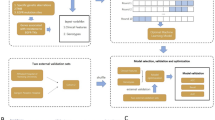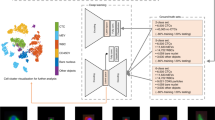Abstract
A cut-off of 5 circulating tumor cells (CTCs) per 7.5 ml of blood in metastatic breast cancer (MBC) patients is highly predictive of outcome. We analyzed the relationship between CTCs as a continuous variable and overall survival in immunohistochemically defined primary tumor molecular subtypes using an artificial neural network (ANN) prognostic tool to determine the shape of the relationship between risk of death and CTC count and to predict individual survival. We analyzed a training dataset of 311 of 517 (60%) consecutive MBC patients who had been treated at MD Anderson Cancer Center from September 2004 to 2009 and who had undergone pre-therapy CTC counts (CellSearch®). Age; estrogen, progesterone receptor, and HER2 status; visceral metastasis; metastatic disease sites; therapy type and line; and CTCs as a continuous value were evaluated using ANN. A model with parameter estimates obtained from the training data was tested in a validation set of the remaining 206 (40%) patients. The model estimates were accurate, with good discrimination and calibration. Risk of death, as estimated by ANN, linearly increased with increasing CTC count in all molecular tumor subtypes but was higher in ER+ and triple-negative MBC than in HER2+. The probabilities of survival for the four subtypes with 0 CTC were as follows: ER+/HER2− 0.947, ER+/HER2+ 0.959, ER−/HER2+ 0.902, and ER-/HER2− 0.875. For patients with 200 CTCs, they were ER+/HER2− 0.439, ER+/HER2+ 0.621, ER−/HER2+ 0.307, ER−/HER2− 0.130. In this large study, ANN revealed a linear increase of risk of death in MBC patients with increasing CTC counts in all tumor subtypes. CTCs’ prognostic effect was less evident in HER2+ MBC patients treated with targeted therapy. This study may support the concept that the number of CTCs, along with the biologic characteristics, needs to be carefully taken into account in future analysis.





Similar content being viewed by others
References
Cristofanilli M, Budd GT, Ellis MJ et al (2004) Circulating tumor cells, disease progression, and survival in metastatic breast cancer. N Engl J Med 351:781–791
Cristofanilli M, Hayes DF, Budd GT et al (2005) Circulating tumor cells: a novel prognostic factor for newly diagnosed metastatic breast cancer. J Clin Oncol 23:1420–1430
Bauernhofer T, Zenahlik S, Hofmann G et al (2005) Association of disease progression and poor overall survival with detection of circulating tumor cells in peripheral blood of patients with metastatic breast cancer. Oncol Rep 13:179–184
Hayes DF, Cristofanilli M, Budd GT et al (2006) Circulating tumor cells at each follow-up time point during therapy of metastatic breast cancer patients predict progression-free and overall survival. Clin Cancer Res 12:4218–4224
Budd GT, Cristofanilli M, Ellis MJ et al (2006) Circulating tumor cells versus imaging–predicting overall survival in metastatic breast cancer. Clin Cancer Res 12:6403–6409
Riethdorf S, Fritsche H, Muller V et al (2007) Detection of circulating tumor cells in peripheral blood of patients with metastatic breast cancer: a validation study of the CellSearch system. Clin Cancer Res 13:920–928
Dawood S, Broglio K, Valero V et al (2008) Circulating tumor cells in metastatic breast cancer: from prognostic stratification to modification of the staging system? Cancer 113:2422–2430
De Giorgi U, Valero V, Rohren E et al (2009) Circulating tumor cells and [18F]fluorodeoxyglucose positron emission tomography/computed tomography for outcome prediction in metastatic breast cancer. J Clin Oncol 27:3303–3311
Bidard FC, Mathiot C, Degeorges A et al (2010) Clinical value of circulating endothelial cells and circulating tumor cells in metastatic breast cancer patients treated first line with bevacizumab and chemotherapy. Ann Oncol 21(9):1765–1771
De Giorgi U, Valero V, Rohren E et al (2010) Circulating tumor cells and bone metastases as detected by FDG-PET/CT in patients with metastatic breast cancer. Ann Oncol 21:33–39
Royston P, Altman DG, Sauerbrei W (2006) Dichotomizing continuous predictors in multiple regression: a bad idea. Stat Med 25:127–141
Botteri E, Sandri MT, Bagnardi V et al (2010) Modeling the relationship between circulating tumour cells number and prognosis of metastatic breast cancer. Breast Cancer Res Treat 122:211–217
Biganzoli E, Boracchi P, Mariani L, Marubini E (1998) Feed forward neural networks for the analysis of censored survival data: a partial logistic regression approach. Stat Med 17:1169–1186
Schwarzer G, Vach W, Schumacher M (2000) On the misuses of artificial neural networks for prognostic and diagnostic classification in oncology. Stat Med 19:541–561
Eleuteri A, Tagliaferri R, Milano L, De PS, De LM (2003) A novel neural network-based survival analysis model. Neural Netw 16:855–864
Ripley RM, Harris AL, Tarassenko L (2004) Non-linear survival analysis using neural networks. Stat Med 23:825–842
Eleuteri A, Aung MS, Taktak AF, Damato B, Lisboa PJ (2007) Continuous and discrete time survival analysis: neural network approaches. Conf Proc IEEE Eng Med Biol Soc 2007:5420–5423
Damato B, Eleuteri A, Fisher AC, Coupland SE, Taktak AF (2008) Artificial neural networks estimating survival probability after treatment of choroidal melanoma. Ophthalmology 115:1598–1607
Harrell FE Jr, Califf RM, Pryor DB, Lee KL, Rosati RA (1982) Evaluating the yield of medical tests. JAMA 247:2543–2546
Tibbe AG, Miller MC, Terstappen LW (2007) Statistical considerations for enumeration of circulating tumor cells. Cytometry A 71:154–162
Fehm T, Sauerbrei W (2010) Information from CTC measurements for metastatic breast cancer prognosis-we should do more than selecting an “optimal cut point”. Breast Cancer Res Treat 122:219–220
Fehm T, Muller V, Aktas B et al (2010) HER2 status of circulating tumor cells in patients with metastatic breast cancer: a prospective, multicenter trial. Breast Cancer Res Treat 124(2):403–412
Riethdorf S, Muller V, Zhang L et al (2010) Detection and HER2 expression of circulating tumor cells: prospective monitoring in breast cancer patients treated in the neoadjuvant GeparQuattro trial. Clin Cancer Res 16:2634–2645
Flores LM, Kindelberger DW, Ligon AH et al (2010) Improving the yield of circulating tumour cells facilitates molecular characterisation and recognition of discordant HER2 amplification in breast cancer. Br J Cancer 102:1495–1502
Pestrin M, Bessi S, Galardi F et al (2009) Correlation of HER2 status between primary tumors and corresponding circulating tumor cells in advanced breast cancer patients. Breast Cancer Res Treat 118:523–530
Meng S, Tripathy D, Shete S et al (2004) HER-2 gene amplification can be acquired as breast cancer progresses. Proc Natl Acad Sci USA 101:9393–9398
Fehm T, Hoffmann O, Aktas B et al (2009) Detection and characterization of circulating tumor cells in blood of primary breast cancer patients by RT-PCR and comparison to status of bone marrow disseminated cells. Breast Cancer Res 11:R59
Kennecke H, Yerushalmi R, Woods R et al (2010) Metastatic behavior of breast cancer subtypes. J Clin Oncol 28:3271–3277
Dawood S, Broglio K, Buzdar AU, Hortobagyi GN, Giordano SH (2010) Prognosis of women with metastatic breast cancer by HER2 status and trastuzumab treatment: an institutional-based review. J Clin Oncol 28:92–98
Marty M, Cognetti F, Maraninchi D et al (2005) Randomized phase II trial of the efficacy and safety of trastuzumab combined with docetaxel in patients with human epidermal growth factor receptor 2-positive metastatic breast cancer administered as first-line treatment: the M77001 study group. J Clin Oncol 23:4265–4274
Ferretti G, Felici A, Papaldo P, Fabi A, Cognetti F (2007) HER2/neu role in breast cancer: from a prognostic foe to a predictive friend. Curr Opin Obstet Gynecol 19:56–62
Bozionellou V, Mavroudis D, Perraki M et al (2004) Trastuzumab administration can effectively target chemotherapy-resistant cytokeratin-19 messenger RNA-positive tumor cells in the peripheral blood and bone marrow of patients with breast cancer. Clin Cancer Res 10:8185–8194
Rosner B (2006) Fundamentals of biostatistics, 6th edn. Thomson/Brooks Cole, Belmont, p 782
Acknowledgments
We thank Ann M. Sutton from the Department of Scientific Publications at The University of Texas MD Anderson Cancer Center for reviewing the manuscript. This study was supported by State of Texas Rare and Aggressive Breast Cancer Research Program (MC); Novel Targets for Treatment and Detection of Inflammatory Breast Cancer (MC, JMR); and Human Breast Cancer Stem Cell Surrogates, CA138239-02, NIH/NCI (MC, JMR).
Author information
Authors and Affiliations
Corresponding author
Rights and permissions
About this article
Cite this article
Giordano, A., Giuliano, M., De Laurentiis, M. et al. Artificial neural network analysis of circulating tumor cells in metastatic breast cancer patients. Breast Cancer Res Treat 129, 451–458 (2011). https://doi.org/10.1007/s10549-011-1645-5
Received:
Accepted:
Published:
Issue Date:
DOI: https://doi.org/10.1007/s10549-011-1645-5




